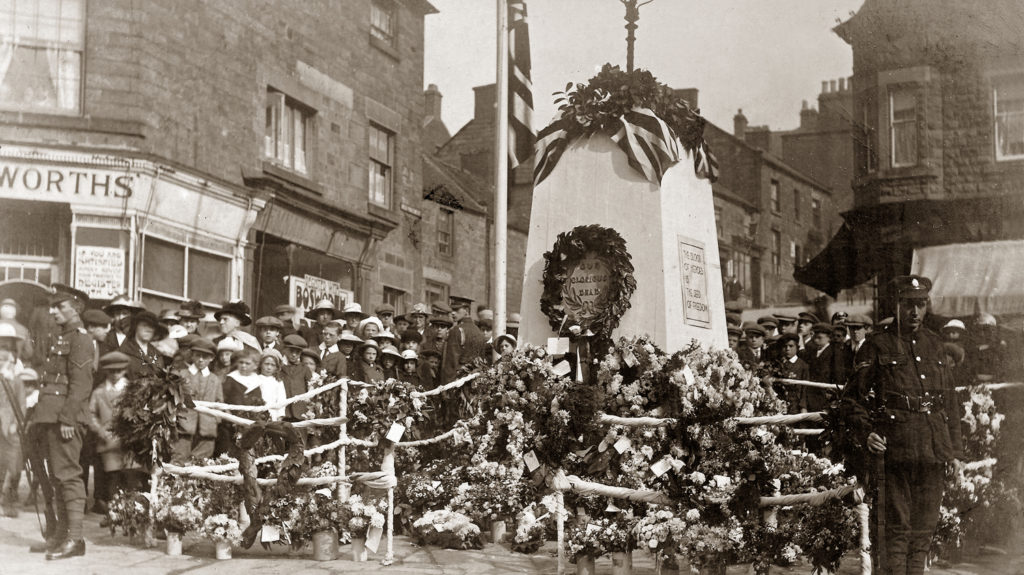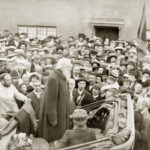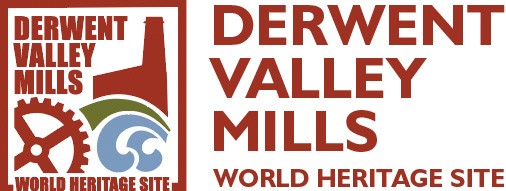b13

This is part of a heritage trail around Belper, taking in some of the key historic areas, and talking about some of the people involved in the development of the town. You can find a map of the trail, and information on where to find interpretation boards containing more details on the town and its history at www.derwentvalleymills.org/belper.
The Market Place
The Market Place began as Belper’s village green, referred to as ‘The Green’ in some early directories and logbooks. Markets weren’t held in the village until 1739, and were initially, it is believed, held a little further down the hillside. As the town grew with the arrival of the Strutt family’s cotton mills, the Market Place became a muddy scrap of land, hard to use for markets, particularly in winter. George Henry Strutt had the whole site paved in stone in 1880, and in thanks the people of Belper erected a memorial to commemorate his paying for this scheme.
The Temporary Cenotaph
After the First World War, a temporary ‘hollow’ cenotaph was built around the memorial, until a permanent replacement could be built, in what became the Memorial Gardens. The cenotaph was recreated in 2014 for the centenary of the outbreak of the Great War, by the Belper in Wartime Group (www.belperinwartime.org)
John Wesley’s visit
John Wesley, the founder of Methodism, visited Belper on Wednesday 5 July, 1786. In his journal he wrote: ‘Notice was given without my knowledge of my preaching at Belper, seven miles short of Derby. I was nothing glad of this, as it obliged me to quit the turnpike road to hobble over a miserable common. The people, gathered from all parts, were waiting. So I went immediately to the Market Place, and standing under a large tree testified ‘This is life eternal to know Thee, the only true God, and Jesus Christ whom Thou hast sent.’ The tree may have been the one which at one time stood outside the Angel Inn, seen in this 19th century illustration. The image shows the proliferation of public houses and inns in the Market Place at that time, including the Black Swan in the foreground. Note the chain across the road between King Street and Market Place – there was a charge to use this turnpike road.
July, 1786. In his journal he wrote: ‘Notice was given without my knowledge of my preaching at Belper, seven miles short of Derby. I was nothing glad of this, as it obliged me to quit the turnpike road to hobble over a miserable common. The people, gathered from all parts, were waiting. So I went immediately to the Market Place, and standing under a large tree testified ‘This is life eternal to know Thee, the only true God, and Jesus Christ whom Thou hast sent.’ The tree may have been the one which at one time stood outside the Angel Inn, seen in this 19th century illustration. The image shows the proliferation of public houses and inns in the Market Place at that time, including the Black Swan in the foreground. Note the chain across the road between King Street and Market Place – there was a charge to use this turnpike road.
William Booth and the Salvation Army

The founder of the Salvation Army, General William Booth claimed he was descended from Belper nail-makers. In 1905, as part of a national tour for the 40th anniversary of the organisation, General Booth came to Belper, and gave an address at the Salvation Army building in the Market Place. The Salvation Army Citadel in Belper has moved a number of times, being at the rear of the Railway Hotel in King Street, in the Market Place and on Campbell Street. Eventually, they were able to buy land on a corner of the Market Place, where the Angel Inn had stood, and after much fund-raising were able to return to the Market Place and build a citadel which opened in 1935. It still stands today as the No.28 Community Hall.
Thomas Crofts – the Belper Poet
 Born at Woolley Moor near Ashover, Derbyshire in 1815, and one of 11 children, Thomas Crofts came to Belper as a young man to be apprentice to a draper, and stayed in the town for the rest of his adult life. He married Martha Walker, the sister of a prominent Belper lawyer probably in 1840. Their first child was born in 1841. By 1842, he had his own drapery business, adjoining the Market Place. By 1891 he had retired from this business and was living with his daughter in The Orchard, off Market Street Lane (what we now call ‘Green Lane’).
Born at Woolley Moor near Ashover, Derbyshire in 1815, and one of 11 children, Thomas Crofts came to Belper as a young man to be apprentice to a draper, and stayed in the town for the rest of his adult life. He married Martha Walker, the sister of a prominent Belper lawyer probably in 1840. Their first child was born in 1841. By 1842, he had his own drapery business, adjoining the Market Place. By 1891 he had retired from this business and was living with his daughter in The Orchard, off Market Street Lane (what we now call ‘Green Lane’).
Thomas was known locally as the Belper Poet. A newspaper report of his funeral in June 1904 states: ‘We must not neglect reference to his sarcastic and cynical effusions at elections, both Parliamentary and local. His skits were always looked for with interest, whether they were to ridicule or flatter, for opponent or friend; for candidates for public office or to turn the electors from what he considered the correct line of conduct. A decided Radical in his politics, he had always been on the platform for his party and did very useful service over his long and honourable life.’
He was an active member of the Belper Congregational Church, an influential force in the town. Among its members he will have found others who like himself campaigned for better conditions for working people. It may have been here he came to know hosiery manufacturer Jabez Brown whose sudden death during a Sunday service prompted Crofts to write his poem On the Death of a Dear Friend J B. The funeral eulogy at the Congregational Church claimed his membership had been 59 years and his poetry spanned over 70 years.
Croft’s life would seem to have been defined by his Christian faith, his love of the natural world and his politics. He campaigned tirelessly for the Liberals and in 1880 was among those who formed the Belper Liberal Association. His views placed him on the left of the party at a time when there were doubts whether the party leaders really understood the needs of working men and could serve their interests .Though fiercely loyal in attending political meetings in and around Belper and sometimes appearing as a speaker, Crofts does not seem to have attained political office. He did however serve as President of the Belper Philosophical Society for the year 1887-8.
His accolade as the Belper poet should not be allowed to mask his occasional heartfelt forays onto the national stage when he acknowledges his admiration and respect for three of his political heroes, Richard Cobden and John Bright on their deaths in 1865 and 1889 and Gladstone on his eightieth birthday, also in 1889. Much of his poetry is the work more of a versifier than a poet and would be dismissed by scholars as doggerel rather than poetry but it is clear he was respected by his contemporaries and he should be afforded his place as an authentic voice of his time.
“A Castle In The Air and Other Poems” is his only book, published in 1892, and containing work dating from over a fifty year period of writing. One of these poems was ‘A Pen and Ink Sketch of A South Derbyshire Town’, written in 1850, about the town he knew best…
The town of which I’m writing stands on a river’s side,
It has streets both crook’d and narrow, and others straight and wide.
It has mills and factories worked both by water and by steam
And high and costly warehouses like stately mansions seem.
It has nail shops past my counting, where men and women toil,
Making “roundheads,” ”forties,” “clinkers,” for the tillers of the soil.
It has churches new and spacious, fitted up with bench and pew,
And of dissenting chapels, it containeth not a few.
It has schools-infant, national governmental, voluntary,
And a “union” and a lockup just the state of things to vary;
It has workers, countless workers, at the anvil, loom and frame,
Yet it holds no lordly mansion,’though it boasts a titled name.
It has gas in great abundance, and yet it’s streets are dark,
And water bright and gushing at a fountain in the park.
It has a railway running through it, with trains both up and down,
And a station house to walk to, near a mile from out of town;
But if you’re in a hurry, and are wishing off to start,
The bus may take you just in time to see the train depart.
It has inns and beer shops plenty, where men have drunk and drowned
Their reason and their sorrow till their giddy brains went round.
It has a fair and statues, market and market place,
Which is a standing monument, of somebody’s disgrace.
It has doctors, clever doctors, who will potion and will pill you,
And if they cannot cure you, be assured they will not kill you.
It is the town I cherish, all other towns above,
For it holdeth those that love me, and those I fondly love;
Tis bounded on the westward by a lofty mountains side,
While to the southward spreadeth, a valley rich and wide;
On the east rich coalfields lie, with gems of wealth in store;
On the north are lime stone mountains, where miners dig for ore.
If then I have described it, according to its fame,
Ere this the reader doubtless has given it a name.
Another draper in the Market Place, operating from what is now the ‘Premier’ Convenience Store, was George Loverock and Sons. Loverock had opened the shop by 1846, only a few years after Thomas Crofts began his own business nearby. The shop continued to operate under the Loverock name until at least 1932, but was gone by 1935. Since then it has had a number of uses, including a gun shop and a wine seller.


